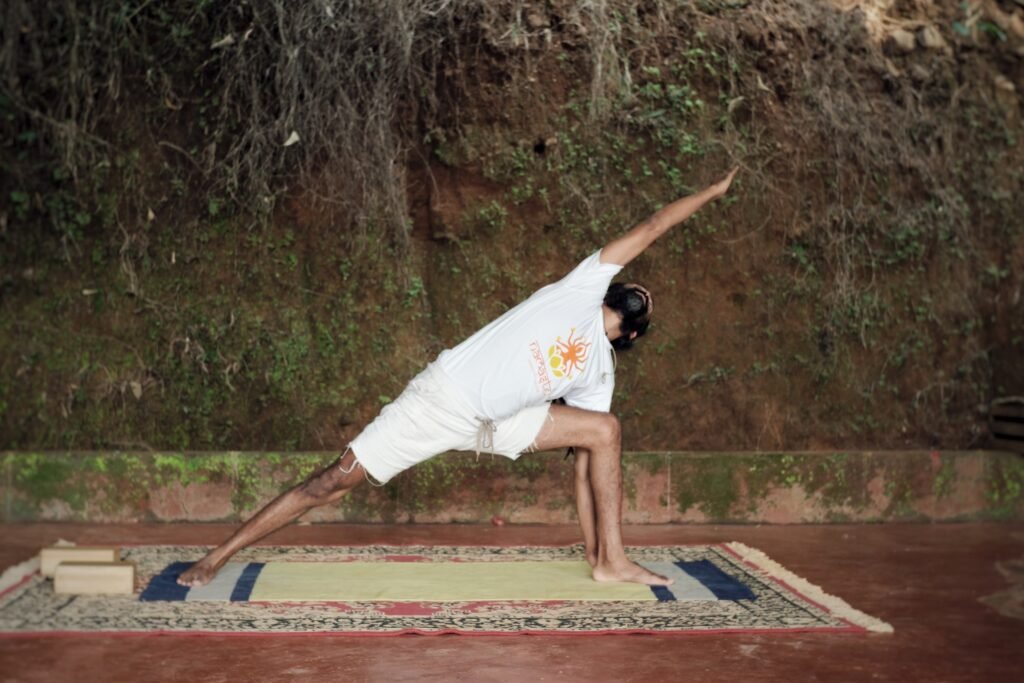
In Sanskrit, “Utthita” means “stretched,” “Parsva” means “side,” “kona” means “angle,” and “asana” means “posture.” Utthita Parsvakonasana means “Body extended to the side with the legs at an angle and the side body” when used together. This standing stance is performed in conjunction with Utthita Trikonasana and Virabhadrasana II, creating a stunning fusion of the two poses. Alignment and a thorough understanding of the body are essential for this pose.
Extended Side Angle Pose is regarded as a base pose since it can be used to create other extended side angle poses.
Extended Side Angle Pose Steps:
- Commence in Tadasana (Mountain Pose). Jump with legs spaced four feet apart. Reach through your fingertips as if your arms were being dragged in opposite directions as you extend your arms into the “T” position with your palms facing down.
- Rotate your right foot inward while rotating your left foot 90 degrees outward. Maintain an even length on both sides of your torso as you lift through your spine.
- With your left knee bent to a 90-degree angle and your left thigh parallel to the floor, press your right outer foot and heel to the floor. Establish a solid base by adjusting your stance.
- Bring your left arm down toward the floor as you lean toward your left knee and hinge at the hips. Put your left fingertips on the ground or a block if you choose. So that your arm and shin are parallel, bring your left armpit up to the outside of your left knee.
- With your palm towards the floor, extend your right arm over your right ear. Form a straight line from your right ankle by turning your torso toward your raised arm and pressing your right hip onto the floor.
- Shift your gaze past your right thumb.In the posture, breathe normally. Spend 30 to 60 seconds there.
- After taking a breath, reach up, lift your torso, and straighten your left leg. Change sides.
Extended Side Angle Pose (Utthita Parsvakonasana) Benefits:
- Leg alignment: Leg alignment is the main focus of this posture, and positioning the foot, ankles, knee, and hip correctly strengthens the muscles across the entire leg. The deep leg also stretches and aids the general lower body’s overall strength.
- Flexibility of joints: This posture strengthens the leg for more advanced poses by providing a deep stretch at the knee, hip, and ankle, and it also increases joint flexibility.All standing balance poses benefit from the flexibility and strengthening of these joints.
- Wide opening of the chest and shoulders: The upper body’s position as the torso moves forward and downwards adds to the wide opening of the chest with a slight twist, taking the shoulder back and out. The muscles around the chest and shoulders are fully expanded by stretching out the arm. This enhances respiration and provides the body with rapid energy.
- Overall body muscle strength: Utthita Parsvakonasana, also known as Extended Side Angle Pose, tones the muscles in the chest, arms, belly, hips, and legs, as well as the muscles surrounding them. It increases and improves strength and endurance.
- Eases back pain: To get the most out of this pose’s benefits, one must be aware of how their body moves while performing it. This posture’s alignment enhances the overall beauty of the body. By regularly performing this stance alongside other poses, backaches can be cured. However, it’s important to pay attention to how the hips move in this position when the body bends to the side. Incorrect alignment could be more harmful than treating the back.
- Flexing the spine: Most postures require that the spine be flexible. Additionally, the spine expands at both ends in the extended side angle pose, from the lower back to the neck. This stimulates the spine to flex and prepares the body for more difficult poses.
- Relaxing abdominal muscles enhances digestion: In this pose, the abdominal organs are stimulated, which promotes digestion. Make sure you practice yoga asana primarily on an empty stomach or wait at least 4 hours between eating and practicing to maximize the benefits.
- Remedies for sciatica: Because stretching and bending also engage the hips and back, these activities can be used to treat sciatica.
- Lessens Menstrual discomfort: Women of all ages can experience less PMS discomfort by frequently practicing this position. With good breathing, massages to the lower belly, lower back, and hips can help relieve PMS or menopause-related symptoms.
- Assists athletes in toning their calves and hamstrings: When athletes perform their warm-up routines, the stretch at the calves and hamstrings in this posture also increases the blood circulation around these muscles. It can be viewed as a calming position after exercising or playing a sport. Precautions should be taken to avoid applying pressure to the knees and ankles.
Extended Side Angle Pose (Utthita Parsvakonasana) Contraindications:
- People with high blood pressure shouldn’t attempt this position until they’ve mastered most less challenging balance poses. Those with high blood pressure may experience discomfort from this pose’s neck and eye movements.
- People with migraines may have trouble moving their heads and neck.
- Not for someone with a weak neurological system or weak joints. It becomes necessary to address the migraine circumstances with pranayama before trying the practice of this position. The joint pressure could render the position insufficient and cause more joint damage if done wrong.
- This pose must be avoided if you have injured hips or legs since they might not be able to support you.
